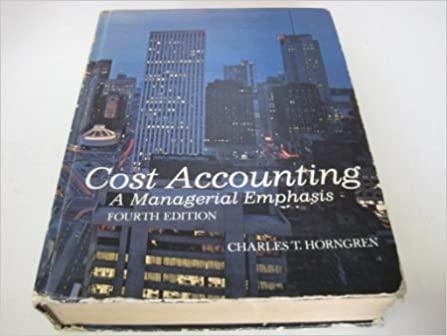Learning Curve, Cost Predictions, and Pricing The Boeheed Corporation is a large, multidivision company with annual sales
Question:
Learning Curve, Cost Predictions, and Pricing The Boeheed Corporation is a large, multidivision company with annual sales in excess of one billion dollars.
One of Boeheed’s divisions, the Spriggs Division, manufactures aircraft. The division is currently developing a new type of aircraft that will determine the success of the division for the next few years.
Spriggs has already spent $200 million on developing and testing the new technology that the aircraft will utilize. It is also constructing a new $20 million specialized-production facility, which would become totally obsolete after production of the planes was completed. The engineering department has predicted that an additional $20 million will have to be spent on further development and testing before the aircraft is ready for production. Boeheed’s accounting policy was to capitalize all development and equipment costs until production actually started.
The division is presently attempting to determine a price for the aircraft.
A price is necessary now because of the long production-schedule lead time of about twelve months, which results from the limited production capacity of ten aircraft per month.
Orders will be made on the basis of this established price, even though deliveries will not be made for one or two years.
The marketing department has forecast that demand for the aircraft will range between 200 and 300 units. The actual demand will be determined by both the ultimate aircraft characteristics and, more important, the aircraft price.
The division has made detailed predictions of the aircraft’s production costs. These predictions have proven to be extremely accurate on previous projects of this type. All the aircraft parts requirements are subcontracted for fabrication. Spriggs has already contracted for parts for 200 aircraft, which will cost $3 million per aircraft. These contracts have a provision for parts for an additional 100 aircraft but at a 10 percent decrease in cost per aircraft.
Direct labor is the most significant element of the production costs. Labor costs are substantial in an absolute sense, but large reductions are possible because of the “learning curve” that affects the labor costs during the production period. The learning curve applicable to the new aircraft is based on tenunit production lots, with the following cost-reduction schedule based on an initial Lot 1 having labor costs of $8 million:
LEARNING CURVE COST PER AIRCRAFT LOT NO. (% OF INITIAL COSTS) (MILLIONS)
1 100% $8.0 2 80 6.4 4 64 Spl 8 51 4.0 12 44 3.5 16 41 3.2 24 35 2.8 32 32 225 For example, the overall direct-labor cost per plane for the seventy-first through the eightieth planes produced should be $4 million per plane, or a total directlabor cost for Lot No. 8 of $40 million.
The general manager and the controller, naturally concerned about setting a unit price for the aircraft, decided to view the new aircraft program as a single job order. They prepared a graph of the predicted direct-labor costs (see Exhibit 7-7). They segmented the graph to develop total direct-labor costs for each segment. They analyzed segments as follows:
AVERAGE DIRECT-LABOR COST SEGMENTS IN EXHIBIT <7 PER UNIT IN SEGMENT 0-40 82% of initial unit cost 41-100 55%
101-200 5 42%
201-300 34%
Combined applicable general, administrative, and indirect production costs are estimated at $50 million annually. Historically, these costs have been applied on the basis of direct-labor costs.
They decided that the fixed costs applicable to the program that must be recovered included $240 million plus whatever indirect production costs and general and administrative costs were incurred. Their prediction of the latter was $100 million if 200 units were produced and sold (2 years * $50 million)
and $150 million if 300 units were produced and sold (3 years X $50 million).
Step by Step Answer:





